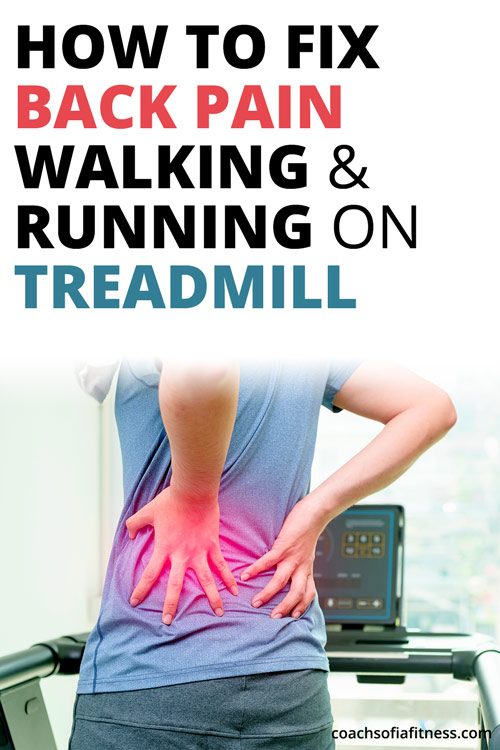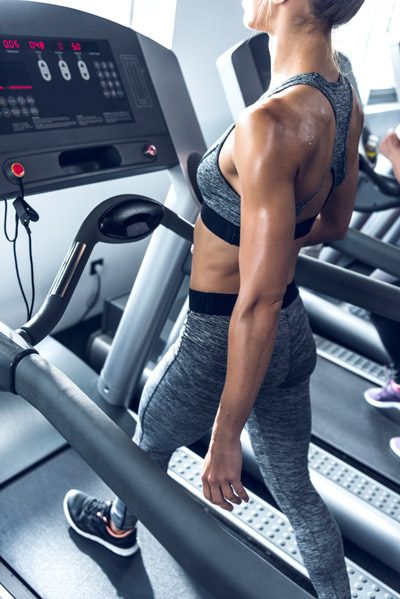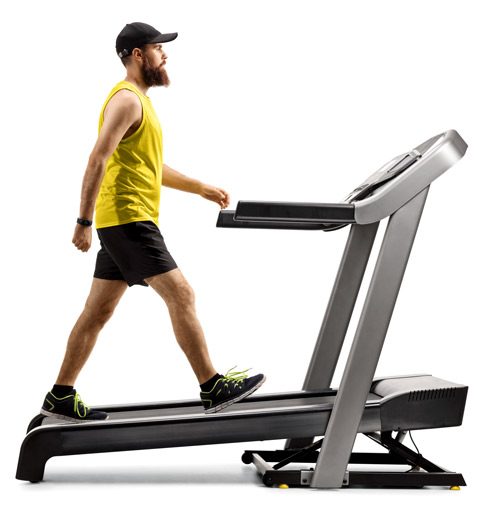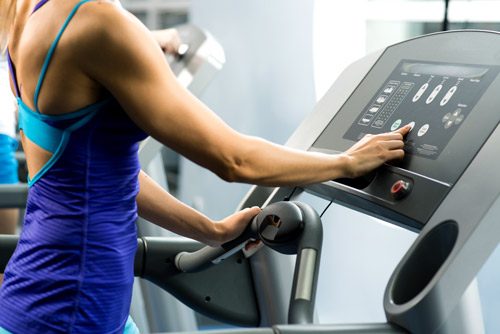If you experience lower back or upper back pain after running on the treadmill, then I’d like to help you in this post…
… I’ll share 5 essential tips that should keep the pain away when using the treadmill.
When I was struggling to heal my disc herniation, sciatica and lower back pain would quickly creep in as soon as I stepped on the treadmill. It was hard to challenge myself and do cardio exercises without feeling that nerve pain.
Strolling was fine. Walking at a slower pace on the treadmill was okay. However, as soon as I increased the intensity, I could feel my hip tightening up and the pain shooting down my hip.
I would also experience upper back pain if I tried to run.
Even today, if I get distracted by looking at my phone, I can feel tension building up when I use the treadmill at an incline.
Improving my posture when using the treadmill played a significant role in improving my treadmill cardio sessions.
The techniques below will help you walk or run on the treadmill with as little pain as possible.
The goal is to avoid pain from the start. But, we know that sometimes it’s not all possible. It will take time to learn and adjust each technique until you reach your optimum goal.
These techniques will also help you walk at an incline and avoid lower back pain and sciatica.

These vital tips are simple. Yet, they make a huge difference, and I hope they’ll help you if you’re planning to do more walking this summer, either outside or inside.
Avoid Leaning Forward
Leaning forward is a common mistake when using the treadmill, especially if you’re increasing the incline.

When using the treadmill, we tend to use our devices to read or watch a program. Especially if you’re using it for more than just a few minutes, otherwise it can get boring.
And before you know it, you’re rounding your back and shoulders
Remember to keep your back straight when using the treadmill. Resist the urge to start looking down or leaning forward.
If you’re increasing the incline, it’s normal to lean forward a little, but you still want to maintain a straight back. Many gyms have mirrors facing the treadmills, which helps you check your posture regularly.
Avoid Looking Down & Flexing Your Neck
I read a lot during cardio, and it’s always a struggle to maintain neck-back posture while also looking down.

What I now do is…if I want to do a long cardio session, I’ll listen to audiobooks and keep a neutral eye level. I’d use my kindle if it’s just a quick 5-minute warm-up session.
Just remember that your posture will follow the direction of your eyes. If you’re looking down, your neck will flex, your upper back will round, and your lower back will flex as well.
Take Breaks When Using The Incline
If you’re experiencing chronic muscular tension, your body will get tired at some point during the incline cardio workout. Step out of the treadmill for a few seconds to catch your breath, take a sip of water, check-in with your body and posture, then step back in to continue.

You’ll give your body a quick break to restore and recover. Implementing these short breaks has helped me get effective cardio sessions without pushing through any discomfort or tension.
The incline is more challenging for your body. It can trigger sciatica and lower back pain.
Keeping your back as straight as possible will reduce spinal compression, especially at an incline.

Engage Your Core
If you tend to develop upper back or lower back pain after using the treadmill or even during the workout, then I highly recommend you spend a few minutes activating the transverse abdominis, and your glutes.
I have many routines to help you do this in just a few minutes that I’ll link right below for you.
In addition, use this opportunity to practice diaphragmatic breathing, which will maintain deep core engagement.
When you breathe in, tighten your belly, hold, and release your breath while maintaining the core brace. After a few seconds, release the core brace, and then repeat in a minute.
You’re working your core muscles while walking or running, which will protect your spine from further damage, and your core will bear the load instead of your back!
I teach the core bracing technique and how to use your deep core muscles to alleviate lower back pain in detail in Back Pain Control program.
Squeeze Your Glutes
Make sure you’re using your glutes when walking or running.
The gluteus maximus muscle is designed to be the strongest muscle in the body. When not engaged and doing its job, you’ll develop hip tightness quickly as the surrounding muscles will kick in to compensate.
A quick way to make sure you’re engaging your glutes is to squeeze them when walking during extension. Every time you extend your leg, squeeze.
All these techniques will ensure you’re not flexing your lumbar spine, transferring more pressure into the lower back.
Below are a few routines you can do before or after using the treadmill to avoid pain.
And keep in mind that you can apply these anywhere you’re walking, hiking, going up and down a hill, or using the treadmill.
Remember that you don’t have to stop doing the things you enjoy. If you like cardio, you can still do it and work around your current limitations.
And by keeping these tips in mind, I’m sure you’ll be able to enjoy it with as little pain as possible.
Helpful routines to do before stepping on the treadmill:
Upper Back Pain When Using Treadmill
Upper back pain when running on the treadmill is also common.
If you’re holding the treadmill bars and using that for support, you may put more stress on the shoulders and neck muscles.
If you get neck and shoulder pain often after exercising, check out my full guide on how to fix upper trapezius and neck pain and the free guide below.
Instead of increasing the intensity and using the bars for support, reduce the intensity and challenge your body by maintaining good posture. You’ll have a more effective workout, and you can always progress as you gain more strength and endurance.
P.S. If you have recurring lower pain. Check out Back Pain Control. This program contains everything you need to help your body heal while also showing you how to be active pain-free.